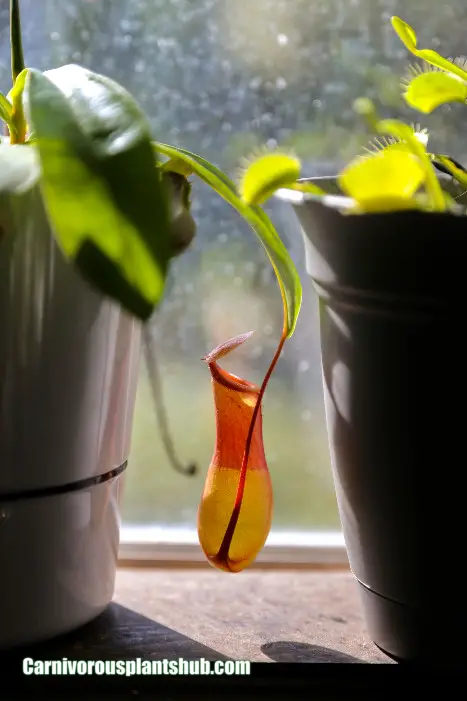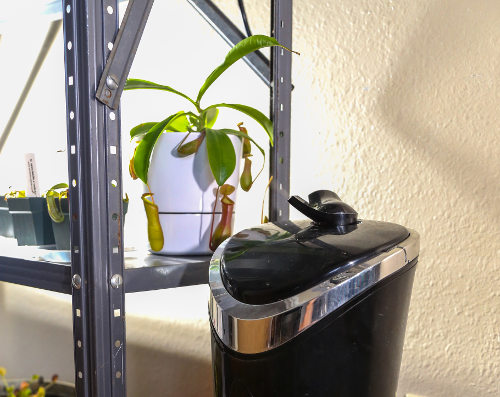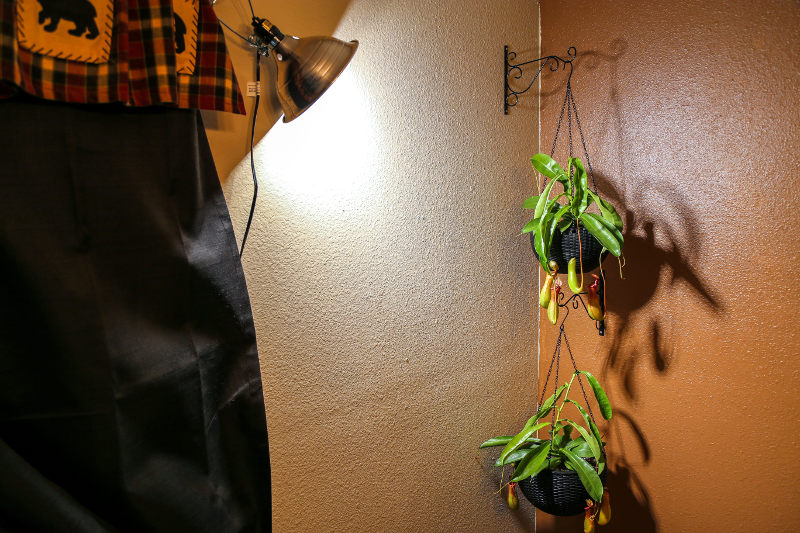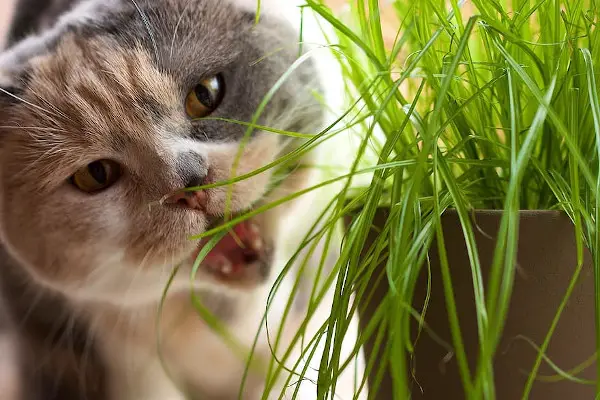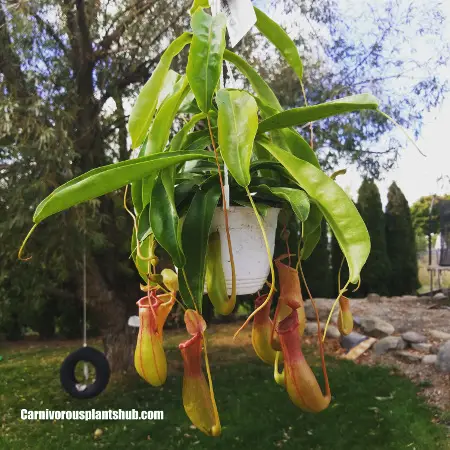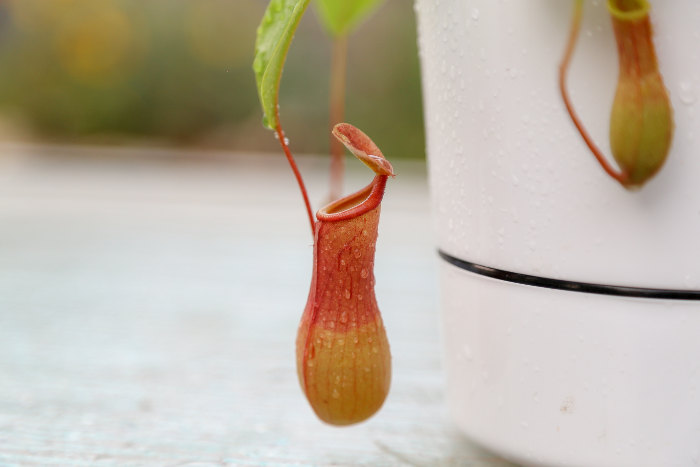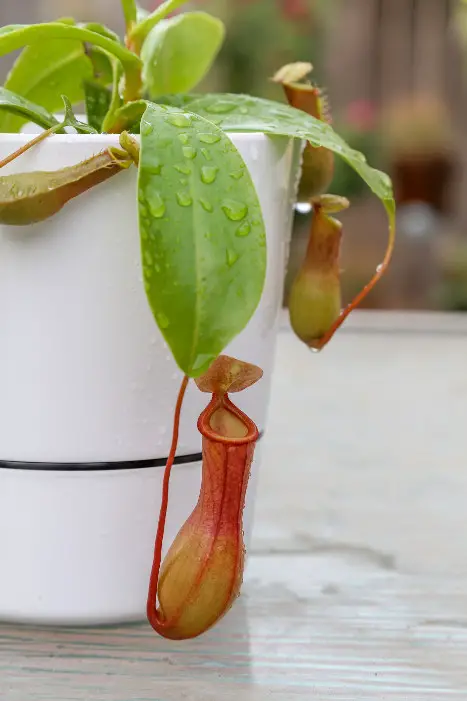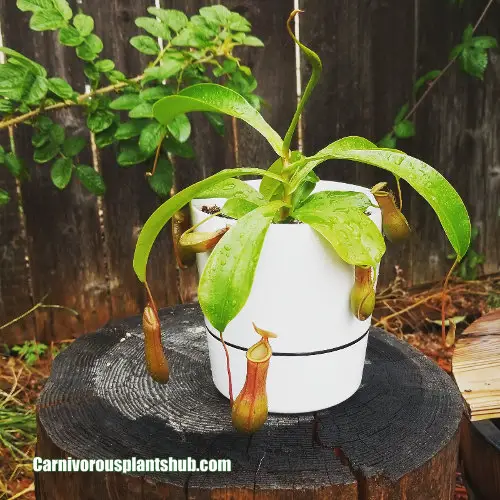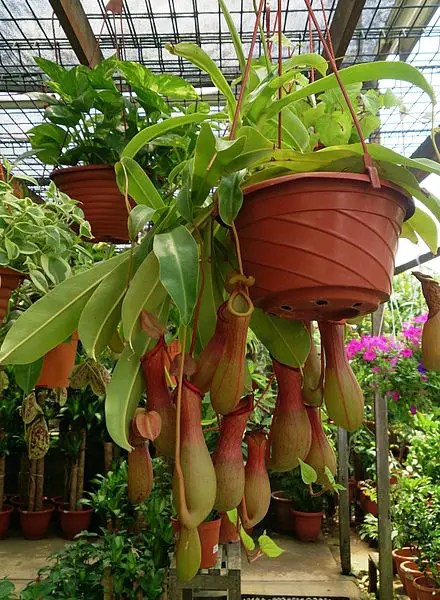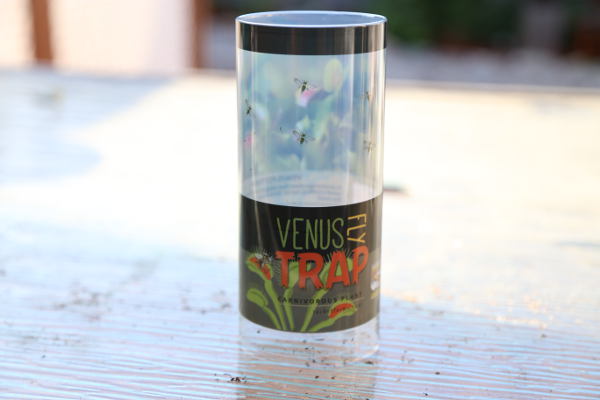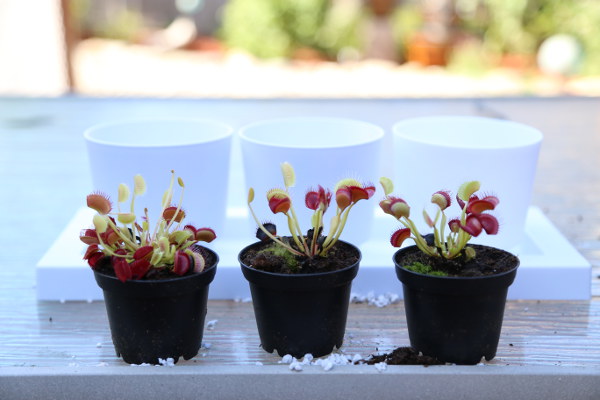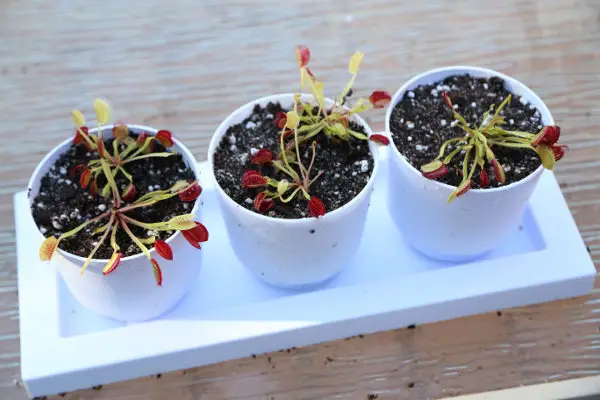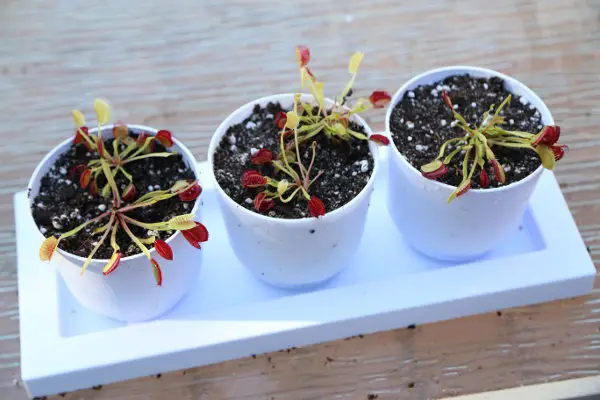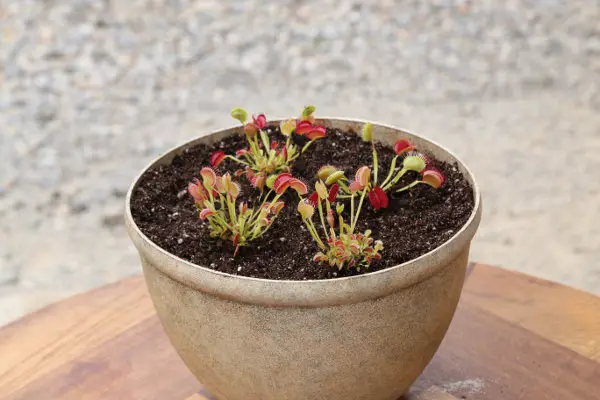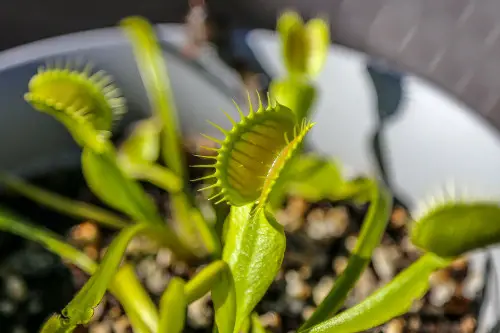One of the most common questions I see is, “Why is my venus flytrap turning black?”. Sometimes its the leaves turning black or an existing trap. Or maybe it’s the new growth turning black. There are lots of reasons why a venus flytrap might turn black, we are going to cover everything.
The first thing I should say is don’t panic. A venus flytrap turning black is a very natural occurrence and even happens to the healthiest of plants. If you have new growth turning black on venus flytraps you might have a bigger issue. But older traps and leaves turning black is nothing to be concerned about in most cases.
The most common reason your venus flytraps turn black is that it’s at the end of its timespan. Flytrap heads turn black and die all the time, it’s no big deal. It also could be due to overfeeding the trap or feeding the trap something that’s too large. Another common reason is dormancy, sometimes when a venus flytrap enters dormancy it looks almost completely dead with traps and leaves turning black. Stress from being repotted or the use of improper soil/water can also be common reasons for a venus flytrap turning black. Improper care with feeding, lighting and watering could certainly be the cause.
Lets dive into all the different reasons and see if we can identify why your venus flytrap is turning black.
Facebook
Pinterest
Twitter
Reddit
Buy Carnivorous Plants Online!
Table of Contents
Why Is My Venus Flytrap Turning Black?
Below we are going to be discussing in detail each reason why your venus flytrap leaves, traps or new growth is turning black. Most likely the black on your venus flytrap is totally natural and nothing needs to be done.
There may be some situations where you need to give your venus flytrap different care. I’m hoping we can identify and diagnose the issue with your venus flytrap!
Most Common Reason: Old Age
The most common reason your venus flytrap is turning black is that it’s at the end of it’s lifespan. After a venus flytrap has opened and closed 3-5 times they expend all their energy and will turn black and die.
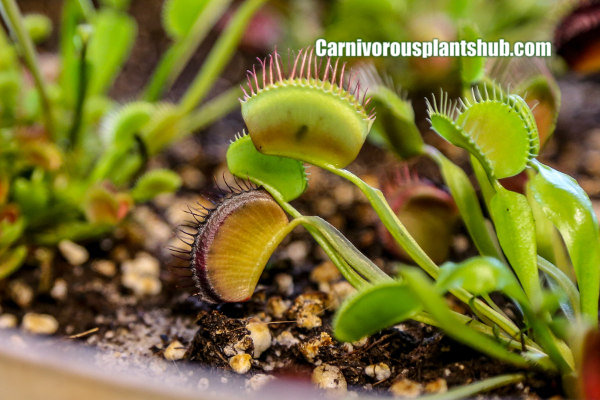
This is really common and happens to all venus flytraps. The plant itself lives a very long time, up to 20 years. However, the traps will come and go pretty commonly. Keep in mind that if you trigger the trap for entertainment, you are decreasing that traps lifespan.
If that trap happens to catch a couple of insects and reopens, it will die quicker than some of the other traps that do not catch an insects. That trap even though it’s turning black and dying, has done a lot to help the plant out.
Stress From Repotting
If you just purchased and repotted your venus flytrap there is a good chance you will lose some flytrap heads before you gain some new ones. Often times the stress of being repotted and acclimating to a new location can aid in turning your venus flytrap plant black.
Just keep in mind that if the heads are turning black after being freshly repotted, you probably do not need to be alarmed. Give your flytrap some time to acclimate to its new environment and it should start sprouting new traps before you know it.
I would keep reading however, to make sure you are taking proper care after repotting your plant. There are a few other things that could go wrong and if you’re not giving your flytrap proper care you could lose your plant.
Overfeeding
I have seen a lot of people who don’t know better try to feed every head on their venus flytrap plant insects. A venus flytrap consumes a lot of energy when it eats an insect. Even though that insect does sent a lot of energy to the main plant, it takes its toll on the existing traps.
The plant can’t support that many traps consuming insects in that short amount of time. This will likely not kill the plant but it could turn most of the existing flytrap heads black.
A venus flytrap should only be fed about 1 fly a week per plant. One head on each plant per week is enough to give the plant what it needs. The plant mostly survives off the light it’s provided, the insects act as fertilizer. Too much fertilizer and it can be harmful to the plant.
If you want to learn more about feeding a venus flytrap, check out my full guide on feeding a venus flytrap.
What & How To Feed A Venus Flytrap Click Here!
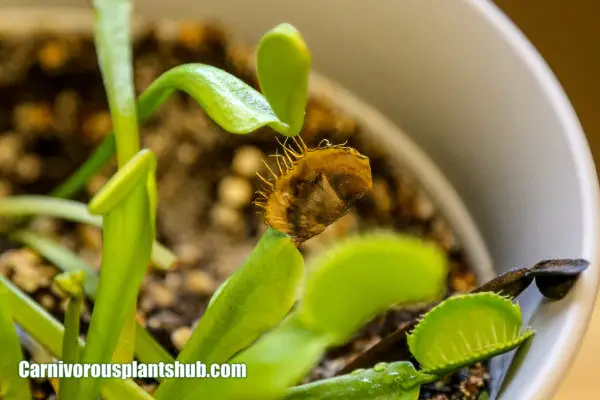
This is a photo of a venus flytrap that ate too large of an insect then eventually died.
Flytrap Ate Too Large Of An Insect
The rule when feeding a venus flytrap is try not to feed it anything bigger than 1/3 the size of the trap. Sometimes you can’t help it if the trap catches a larger insect, this usually ends in the trap turning black and dying.
I just had a smaller trap catch a yellow jacket and just about a week later it died. You can watch the video below of me dissecting some of my traps with insects on the inside. It’s a fun look at what the bugs look like after they have been absorbed by the plant.
You won’t always be able to stop your trap from catching larger insects natrually but you can control whether or not you feed your trap large bugs. Make sure when feeding your flytrap not to give them insects that are too large. In my experience this will result in the trap turning black and dying 100% of the time.
https://youtu.be/afE3GsOz08o
Not Using The Correct Soil Or Water
Venus flytraps have fairly special needs due to the way they grow naturally. If you are not meeting those special needs your plant could be unhealthy and could turn black and die.
Substrate/Soil Needs
A venus flytrap needs a special soil mix that contains extremely small or no amounts of minerals. What I use is a peat moss, perlite and silica sand mix. You need to make that your mix has no fertilizer to additives in it. You can buy the soil premade on Amazon if you don’t want to deal with it or you can make it yourself.
Check out below to see the soil you can buy right on Amazon already mixed and ready to use.
- PERFECT GROWING ENVIRONMENT: Organic Earth’s...
- PREMIUM INGREDIENTS: Organic Earth’s carnivorous...
- TREAT YOUR PLANT: Ideal pitcher plant, sundew...
- FOR HEALTHY, THRIVING PLANTS: Ensure to use...
- OUR MISSION: At Organic Earth, we’re dedicated...
Last update on 2024-04-27 / Affiliate links / Images from Amazon Product Advertising API
If you would rather make your own soil mix, I can show you how to below. Also, I have an entire article I wrote all about venus flytrap soil mix. This includes how to make it and much more information.
Venus Fltyrap Soil Information Click Here
I have also made a video showing you exactly how I make this mix, make sure to check it out below!
https://youtu.be/q6WaSVn3bKg
Type Of Water
One of the most common mistakes people make when getting a new venus flytrap is they give it tap water. It’s an honest mistake and not always clear on the plants instructions. The minerals in tap or bottled water will burn the plants roots and eventually kill it. This process will turn the plant black as it’s dying.
It’s important to understand that you will need distilled water, rain water or even water obtained through reverse osmosis. Pure water will be the only kind of water that works for your venus flytrap in the long run.
You can get distilled water at a local grocery or big box store for under $1 a gallon. I usually just pick up 4 or 5 gallons at a time to make sure I have enough for a bit. You can use rain water if you have a way to collect it. You may want to test it however, just to make sure the parts per million is low enough.
Watering Instructions
The other thing that could be happening is your venus flytrap isn’t getting enough water or your overwatering. Make sure you keep your venus flytrap moist but not soaking wet. It’s important to never let your substrate dry out. You also want to avoid adding so much water it makes the substrate muddy.
You can use the tray method to water but you want to be careful not to leave the plant in too deep of water. You can fill a tray with about 1/4 of an inch of distilled water and place the pot in the water. Don’t add more water until the tray completely dries out.
Watering is one of the most common mistakes people make that leads to their venus flytrap turning black. You can read all about how to water a venus flytrap at my full guide below. It has more info about the kind of water and how much water you give a venus flytrap!
Venus Flytrap Watering Guide Click Here
Wrong Pot Or Planter
For a venus flytrap to thrive and avoid turning black you will need to make sure your plant has good water flow and aeration. The pot or planter you choose will have a hand in that. Make sure your pot or planter has good drainage with plenty of holes int he bottom for the water to escape.
Venus flytraps are known to suffer from root rot and standing water can aid in that. You need the water to be able to drain out of the bottom of the planter.
You also want to make sure you avoid any planters that can leech harmful minerals into the soil. Terra cotta for example can leech minerals into the soil and cause the roots to burn. Some clay pots will also leach minerals. I suggest using plastic or resin planters with good drainage. You can get a clay pot, just make sure it’s fully glazed to avoid any leeching.
Check out the planter below I recommend for venus flytraps.
- 【Minimalist Design】 Designed with a matte...
- 【Optional Drainage System】 Not only comes with...
- 【Thick and Durable Material】 Made of...
- 【Make Your Own Garden】 Set of 5 indoor...
- 【Spruce Up Your Room】 Decorative plastic pots...
Last update on 2024-04-27 / Affiliate links / Images from Amazon Product Advertising API
To see what I suggest for good planters, check out my full guide on the best pots and planters for venus flytraps below!
Best Pots And Planters For Venus Flytraps
Winter Dormancy
Many venus flytraps have been discarded due to the dormancy period. Many people mistake normal dormancy for their plant being dead. During dormancy most of the plant will turn black and look dead. Usually there is a little green left, so you can tell, but most people would probably think the plant is dead.
When the days shorten and temperatures drop venus flytraps go into survival mode. They completely stop growing and most current growth dies back to conserve energy. The rhizome spends all winter storing up energy to make a comeback in the spring.
This is how venus fltyraps work in their natural habitats. They have evolved to be able to survive cold winters. You should try to avoid your trap being in whether that dips below 32 degrees too often but there are ways to overwinter your plant to ensure it survives the winter.
Dormancy can be a little tricky with venus flytraps and for your plant to stay healthy it’s necessary. It’s a good idea to learn more about dormancy to make sure your venus flytrap lives a long healthy life. I havea full guide to venus fltyrap dormancy below.
Learn all about overwintering your venus flytrap and how to make sure your plant has a nice comeback after dormancy below.
Venus Flytrap Dormancy Guide
Venus Flytrap Head Turning Black
The most common place for a venus flytrap to turn black in the head or the trap. Usually the tips of the trap will start turning black and the blackness will spread to the rest of the head. It then moves from the head to the leaves.
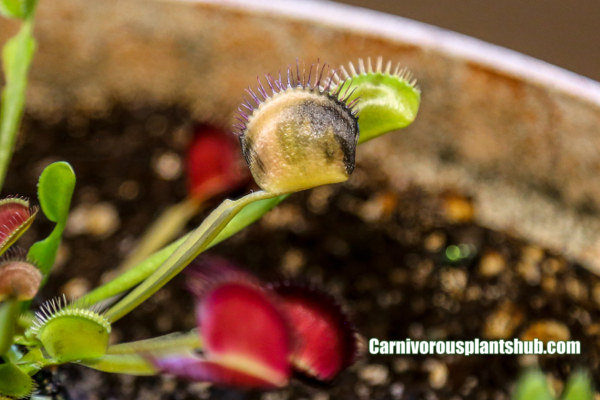
This is most commonly caused by old age but could be because of any of the reasons above. Its totally normal for a trap to turn black and die. If all your traps are turning black and dying, use the information above to determine if you are doing something wrong with your venus flytrap care.
Another really common reason the venus flytrap head turns black is from it eating an insect that is too large. In my experience, every trap that eats a large insect starts turning black and dying within a week. Don’t panic at this unless all your venus flytrap heads start turning black. Then you may need to change care habits or consider it could be dormancy setting in.
Venus Flytrap New Growth Turning Black
Its not at all uncommon for a new trap that’s coming up to turn black and die. If you start to see this over and over or all your traps are turning black and dying it could be a bigger problem.
Did you just replant your venus flytrap? Sometimes, if you replant the flytrap the new growth won’t do very well until the plant gets acclimated. Make sure it’s getting a lot of sunlight and being kept watered with distilled water and new healthy traps should start popping up.
Make sure you have optimal growing conditions for your venus flytrap. It needs a lot of sun or light to grow healthy. Venus flytraps like a full days sun if possible, if not, you may need grow lights to supplement the light it needs. Venus flytrap new growth will turn black if the plant is not getting enough light.
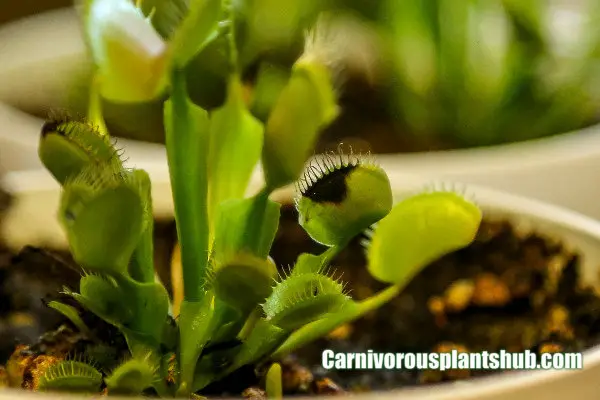
It’s also important to make sure the plant is getting distilled water and being kept moist. If the plant dries out, the venus flytrap new growth may turn black.
Keep the plant watered well and give it plenty of sun to avoid any new growth from turning black! Just keep in mind that on occasion a new growth will turn black, don’t be alarmed. I would only look into it if you see this repeat or if all new growth is turning black.
Venus Flytrap Leaves Turning Black
If just the leaves of your venus flytrap are turning black you may have a slightly different problem. Sometimes if your have too much sun or light and they get too hot they could burn. You see this when a venus flytrap is put in a glass terrarium. The glass magnifies the sun and burns the plant.
Another cause for this could be if your using tap water with minerals. The water can get on the leaves and the minerals burn them and cause black spots. Make sure you are only watering with distilled or pure water.
If the edges of your venus flytrap leaves are turning black it’s probably alright. As long as the black isn’t spreading to the entire plant you probably have nothing to worry about. Make sure you are following all the care instructions above and your plant should be okay.
Sometimes stress from replanting or too much sun can cause the edges of the leaves to turn black a bit. Watch your plant, if the rest of the plant seems to be doing fine, it’s probably okay!
Should You Cut Off Black Venus Flytraps?
Cutting off black venus flytraps is really not necessary. It’s mostly an aesthetic decision. I will admit, I love the way my venus flytraps look right after cutting off all the older black dead leaves and flytraps. There are a few things to keep in mind when cutting off black flytraps.
Never cut off any green parts of your plant. If it’s green, it’s helping. Anything that’s green is absorbing sun and helping with photosynthesis. The more green collecting sun and light the more healthy your plant will be.
I usually don’t touch black flytraps until they black goes all the way back to the rhizome. If it’s black all the way back to the main plant, you know it’s served its purpose and is no longer helping the health of the plant.
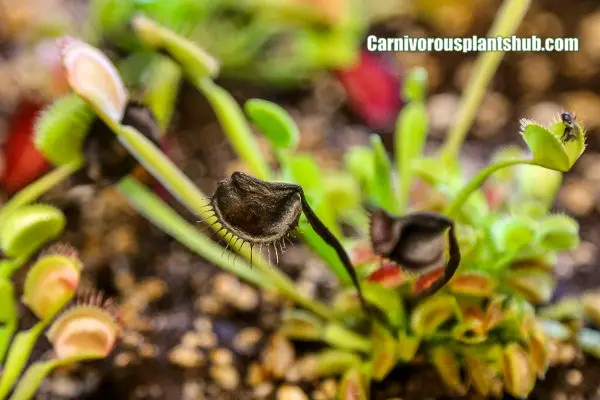
This trap would be okay to cut off since you can see the leaf is black all the way back to the rhizome.
Keep in mind, it’s not necessary to cut it at this point. The black flytrap will eventually decompose and fall off. Just make sure if you decide to cut off black growth that you avoid cutting any of the green. Even if the head is all black and the leaf is still green, just cut the head off and leave the green stem.
Cutting off black flytraps is 100% optional but a freshly trimmed flytrap does look really nice! Its especially nice to trim them freshly after dormancy as a lot of the plant will be black and dead.
More Great Stuff From CarnivorousPlantsHub.com!
Final Thoughts
Often times when your venus flytrap is turning black, there is really nothing to worry about. The normal course of life will happen with these plants and they will turn black and die. But, it’s a really good idea to go over the information above to make sure you are doing everything you can help keep your venus flytrap healthy.
Venus flytrap care is not really standard in the gardening world and often times growers learn this the hard way by killing their plant. You should be able to determine why your venus fltyrap is turning black by going over the information in this article.
If you thought this content was good, please make sure to subscribe to my YouTube channel below. I want to start a carnivorous plant nursery someday and you subscribing to my channel supports that dream! Check out one of my recent unboxing videos below to see if it’s something you might like!
You can also check me out on Instagram or Pinterest below! Also, if you are interested in convervation efforts of carnivorous plants, check out the International Carnivorous Plant Society for more info!





